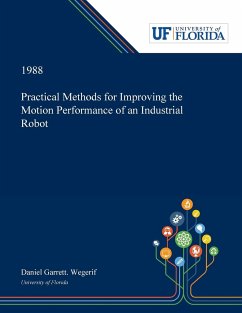Abstract: Industrial Robots used to perform machining operations are affected by resulting cutting forces. Using modal analysis, the position-dependent flexibility model of the robot was created. Measuring the cutting forces in real-time using a wrist mounted 6-DOF force sensor, tooling deflections were predicted and compensated for using a single DOF high-speed position compensation device. The resulting cutting force induced deflections were significantly reduced using this compensation method. Dissertation Discovery Company and University of Florida are dedicated to making scholarly works more discoverable and accessible throughout the world. This dissertation, "Practical Methods for Improving the Motion Performance of an Industrial Robot" by Daniel Garrett. Wegerif, was obtained from University of Florida and is being sold with permission from the author. A digital copy of this work may also be found in the university's institutional repository, IR@UF. The content of this dissertation has not been altered in any way. We have altered the formatting in order to facilitate the ease of printing and reading of the dissertation.
Bitte wählen Sie Ihr Anliegen aus.
Rechnungen
Retourenschein anfordern
Bestellstatus
Storno








